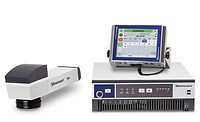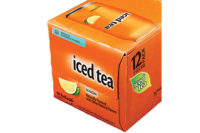Beverage Coding
By JOANNA COSGROVE
Coding suppliers devise systems with more reliable
output
Beverages are bottled in
environments that are notoriously harsh to processing equipment. Coding
equipment has it especially tough. The performance of high-tech lasers and
ink jets are exceedingly influenced by temperature fluctuation, wetness,
humidity and errant debris.
Last month, Videojet, Wood Dale, Ill., dispatched one
of its newest laser coders — a Videojet 3410 50-watt CO2 steered-beam
laser coder — to mark bottles produced by a contract beverage filler
based in the southeast region of the United States. According to
Videojet’s Jim Lorenz, product manager responsible for the North
American laser business, the coder employs an air knife approach to
simultaneously clean and dry the laser scan heads, while cleaning and
drying the product’s absolute marking area, thereby surmounting
unfavorable processing conditions while increasing output speeds.
Individual marks are made by using the laser to literally burn ink from the
label, thus creating the mark.
“Our customer was
producing about 1,000 marked bottles per minute, but this laser’s
speed has upped their production output, enabling them to obtain speeds of
up to 1,250 to 1,300 bottles per minute,” he says. “The
production line is already situated in a hot, humid environment, and when
you print that fast, your laser becomes very hot. As a result, if the laser
is not properly cooled and protected against the environment, the life of
the laser is diminished considerably.”
Lorenz says the laser carries an IP 5 rating since the
laser tube is internally well-cooled, and protects against dust and
moisture, even in high-heat and humidity environments. “There are a
lot of lasers that code on beverage industry labels, but this one is unique
because we expect the life of the laser to be long due to the way the laser
is protected and cooled against the environment,” he says.
Markem Corp.’s SmartLase low-power, CO2 laser
also takes into account the wear and tear effect on its laser. Its
“patented technology allows the laser to cycle on and off only once
during the printing of an entire code, unlike vector printing which
requires the laser to cycle on and off with each character,” says
Elaine Greene, senior marketing representative at Markem, Keene, N.H.
“To clarify how this impacts reliability, think of a light bulb. When
does a light bulb typically fail? It fails when you flip the switch on. The
less the laser is turned off and on, the less stress is applied to the
laser.”
The SmartLase’s patented dot matrix technology,
ideal for PET, aseptics and glass, makes efficient use of energy, reducing
power requirements, and in doing so, lowering operating costs.
Coding against the odds
In addition to the aforementioned conditions that can
impact the longevity and output reliability of laser coders, some of the
most common problems that can occur in the realm of beverage coding center
on condensation and its ability to wreck havoc with a code’s lasting
integrity.
Many equipment suppliers market coders designed to
excel in wet conditions. Among them is the Ci Series from ID Technology
Corp., Fort Worth, Texas. A line of small-character continuous inkjet
printers, the Ci Series features immediate dry times, top-notch adhesion
and high-quality print for applying beverage date codes, expiry dates and
lot codes. Its high-contrast, yellow pigmented inks work especially well on
dark surfaces or on clear bottles containing dark products.
Guy Bradford, inkjet product manager, adds that the
ciSeries printers are also available with special MEK Plastic Ink that is
ideally suited for printing on most plastics such as polyethylene and
polypropylene as well as most glass and metals. “Its
‘fast-dry’ characteristics and capability of penetrating a
layer of condensation make it an excellent fit
for the beverage industry, especially dairy and juice products,” he
says. “Its excellent penetration and adhesion to waxy and greasy
substrates make it a great fit for these cold-fill applications.”
Within the laser coding realm, ID’s Bill Andre,
laser product specialist, remarks that laser coding works extremely well on
PET. “The permanent mark left by the laser is crisp and very
clear,” he says. “The bottler has the option to use either dot
matrix or vector characters depending on which one gives the best results
on a particular substrate. Marks on labels, PET and glass are easily
achieved either statically or dynamically.”
And for beverages sold by the case or the tray,
Markem’s Model 5000 Series hot melt ink jet tray printers provide the
ability to print detailed logos, graphics and even 100 percent scannable
bar codes onto shrinkwrap and corrugated cardboard, eliminating the need
for an inventory of preprinted trays.
“Unlike other inks,” says the
company’s Greene, “the MARKEM TouchDry hot-melt ink produces a
print that maintains its integrity and legibility regardless of variations
in corrugated or recycled content and is not affected by moisture or
condensation.”
Advancing inks and state-of-the-art coding
technologies are enabling beverage manufacturers and contract producers to
get the most bang for their equipment buck, no
matter how intricate the application. BI
Jose Cuervo unveils new designs
Jose Cuervo International has updated the look of its
Jose Cuervo Especial and Jose Cuervo Clásico premium tequila brands.
A new, slightly taller bottle is complemented by a restyled, contemporary
label that communicates the brand’s Mexican heritage. An embossed
design that includes the family crest, founding date (1795) and phrase
Hecho en Mexico, meaning “Made in Mexico,” along with the
Cuervo signature seal continue to be featured on every bottle.
“The change is subtle but distinctive,”
says Neil Gallo, senior director, North America for Jose Cuervo
International. “We believe it serves to enhance the premium image and
position of our brands without sacrificing the signature look our consumers
know and trust.”
New packaging for Odell Brewing
Odell Brewing recently launched a new English-style
bottle that pays tribute to its English roots. The matte labels are
hand-drawn, conveying the quality of the handcrafted beer inside. The
company says the new designs allow the personality of each beer to shine.
Topping it all is a cap with the redesigned Odell Brewing company logo.
Chardonnay - to go
After being introduced in early 2005, Fetzer Valley
Oaks’ “To Go” wines in unbreakable, recyclable, l87-ml.
bottles are being offered in “go have fun” locations such as
ballparks, golf courses, racetracks and zoos. SBC Park in San Francisco,
home of the San Francisco Giants, the San Diego Zoo and the Louisville
Slugger field are among the first to offer the convenience and safety of
the new wine offerings to fans. Fetzer’s Valley Oaks Ready To Go
wines are also available in four-packs of Chardonnay, Merlot and White
Zinfandel.
Tequila Rose gets a facelift
In September, McCormick Distilling Co.’s
flagship Tequila Rose strawberry flavored cream liqueur and tequila, will
debut new packaging that’s been two years in the making. The new
packaging trades the old stock bottle for a sleek, pyramid-shaped, custom
shell. The bottle has a satin finish, updated label and a more upscale
appearance.
The new Tequila Rose will be available in a variety of
sizes, including 1.75-liter, 1-liter, 750-ml., 375-ml., 200-ml. and 50-ml.
The product also will be available in gift packs featuring the newly
designed bottle in the 750-ml. size with two hand-blown shot glasses etched
with the McCormick logo. The gift packs will be available nationally
starting this month.
Seasonal packaging for Camus Cognac
Camus Cognac, a producer of premium French Cognac,
recently introduced two gift packages for the 2005 holiday season. The
Camus Grand VSOP gift package combines a 750-ml. bottle of Camus’
best-selling cognac with two crystal balloon glasses in an elegantly
designed presentation box. The gift package carries a suggested retail
price of $34.99.
With a suggested retail price of $90, the Camus XO
Supérieur gift package features a 750-ml. crystalline perfume bottle
of Camus’ award-winning cognac and two tasting glasses. Both gift
packages, which began shipping Sept. 1 in cases of six, are available to
U.S. distributors and on- and off-premise establishments through CIL US
Inc., a wholly owned subsidiary of Camus Cognac.
Cool2Go keeps beer colder, longer
Keeping beer cold on a hot summer day used to be a
tough proposition, but the new “Cool2Go” wrap from DuPont,
consisting of a thin insulating layer, protects beer from heat transferred
by warm hands, condensation and outside temperature. The wrap is featured
exclusively on The Labatt Blue Cold One, which is presently available in
only Ontario and Quebec, Canada.
The “Cool2Go” wrap is made by placing a
high-tech, polymer insulation between two layers of DuPont Teijin Films
Melinex polyester film. A patented process produces a thin thermal barrier
that locks in coldness, and the blue hues on the shrinkwrap were created
with DuPont Cyrel NOW plates.
Trigger Cap for beverage blends
Century Foods International, a division of Hormel Foods
Corp., has made available Trigger Cap technology for beverage containers.
The Trigger Cap is a sealed reservoir that can hold up to 8-ml. of
shelf-stable liquid or powder ranging from flavors, electrolytes,
agglomerated supplements or live cultures. The cap features a dished
top that consumers depress to quickly and easily release the contents into
the drink prior to consumption. The cap’s underside contains small
levers that rupture the perforated membrane and hold it open for discharge.
Trigger Cap technology is designed with minimal components so as not to
impede bottling line efficiency.
Are you ready for some football?
Budweiser and Bud Light, the “official beer
sponsors” of 28 National Football League teams, will introduce
team-specific packaging in markets nationwide, allowing football fans to
celebrate the 2005 season while showing support for their favorite team.
All 12 Anheuser-Busch domestic breweries will be
involved in the team-specific packaging campaign, which will produce more
than 78 packaging combinations on 12 million cases of Budweiser and Bud
Light aluminum cans. Team-specific packaging was launched on Aug. 22 in
time for the Labor Day selling period.


